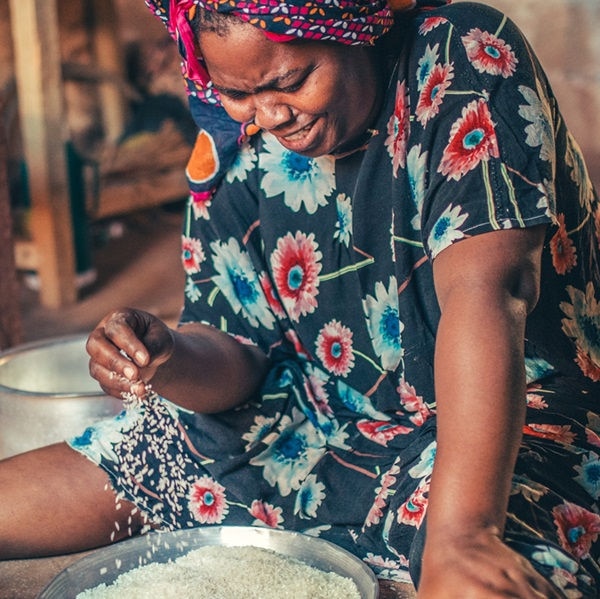News
October 28, 2019
Everything you need to know about fortified rice
As one of the world’s most widely consumed foods, rice plays a significant role in many diets around the globe. Though it is a great source of energy, it is a poor source of micronutrients and has a low overall nutritional value. We discuss how fortified rice can fill nutrient gaps in rice-eating populations.
Why fortified rice?
- Rice is a staple food for more than half of the global population, providing more than 20% of the world’s calorie intake.1
- Rice is widely consumed in many developing countries, where ‘hidden hunger’ is an issue. This offers a unique opportunity for nutrition improvement in the form of rice fortification.
- There are multiple factors to consider when developing sustainable and effective rice fortification programs, which have a positive impact on public health, including which vitamins and nutrients to include and at which level, the how to integrate fortification into the rice supply chain, and ensuring it meets all regulatory requirements.
A global need for nutrients
As one of the world’s most widely consumed foods, rice plays a significant role in many diets around the globe. In low income countries, it can make up to 70% of an individual’s calorie intake.2 Though it is a great source of energy, it is a poor source of micronutrients and has a low overall nutritional value beyond carbohydrates and protein. This is because the milling process that produces white rice removes the fat, as well as the more nutrient-rich bran layers. Parboiled rice, brown rice and bio-fortified rice (for example high-zinc rice) are more nutritious compared to white rice in one or a few essential micronutrients. This is due to different paddy processing or utilizing more nutritious rice varieties. Parboiled rice is also fortified at scale to make it more nutritious, and brown and bio-fortified rice can also be further fortified to close the nutrient gap. In this article the focus will be on post-harvest rice fortification – the addition of several essential vitamins, minerals and potentially other nutrients to make any rice variety more nutritious post-harvest and after paddy processing.
Vitamin and mineral deficiencies are also an issue outside of low-income countries, affecting most regions worldwide at varying levels. While malnutrition is often associated with those not consuming enough calories, the lack of essential vitamins and minerals in ample or high calorie diets is a prominent issue, known as ‘hidden hunger’.
The popularity of rice presents an opportunity to fill the nutrient gap in rice-eating populations worldwide by increasing the nutritional value of rice. A wide variety of vitamins, minerals and other nutrients such as amino acids and fibers can be added post-harvest to effectively address malnutrition and contribute to Sustainable Development Goal 2 (SDG2).
A growing number of countries have mandated rice fortification and are fortifying rice distributed through social safety nets (for example school feeding), or have set voluntary rice fortification standards to address hidden hunger.
Methods to make rice more nutritious
Rice can be made more nutritious by adding vitamins, minerals and other nutrients to replenish micronutrients lost in the milling process and reinforce its nutritional value. Fortifying rice can then help close the nutrient gap by adding to the rice essential nutrients that are lacking in the diet. This can be done without impacting the appearance, taste or cooking practices of the rice, depending on the technology used to fortify the rice.
There are different methods to make rice more nutritious post-harvest:
- Dusting – this is where rice kernels are dusted with a micronutrient powder, relying on an electrostatic force to bind the dry powder to the surface of the grain. Fortified rice produced by dusting cannot be washed or cooked in excess of water.
- Coating – a method that involves the use of a fortificant mix and ingredients such as wax or gum to ‘fix’ the micronutrient layer being sprayed onto rice. The produced fortified kernels are blended with regular rice, typically at 0.5 – 2% ratio.
- Hot or warm extrusion – hot extrusion is considered the most robust method of rice fortification, supported by extensive evidence base to have a positive impact on micronutrient deficiencies. Broken rice grains are ground into rice flour, then mixed with water and the required nutrients to produce a dough. The fortified dough is then passed through an extruder to produce the fortified kernels, which are then blended with regular rice typically at 0.5-2% ratio. The temperature at which the extrusion takes place determines if we speak of hot or warm extrusion and has an influence on the rice starch gelatinization and thus firmness of the produced fortified kernels.
Selecting an appropriate technology and fortificant forms to fortify rice post-harvest is crucial to successfully improve micronutrient health. In countries where rice is frequently washed, soaked or cooked in excess water, dusting will not be effective, and a coating technology needs to be rinse resistant to be effective. To have a positive health impact, fortified rice needs to have good:
- Stability during transport and storage
- Retention during cooking & preparation
- Consumer acceptability
- Absorption by the body of the used micronutrients
Hot extrusion is supported by a robust evidence base and shows excellent consumer acceptability. The fortified rice looks, cooks and tastes the same as non-fortified rice.
Rice fortification terminology (post-harvest)
Benefits of fortification and beyond
The overarching purpose of fortified rice is to meet nutritional goals for the end consumer, but in order for nutritional programs to reach their full benefit, fortification programs need to meet certain requirements in order to be effective.
- Ease of use – this is one of the biggest benefits. As a widely used staple food, it is simple to replace standard rice with fortified rice to boost the nutritional profile of a simple diet. With certain methods of fortification, consumer usage is key in effectiveness. However, advances in fortification technologies, such as the use of hot extrusion, also ensure the added high-quality micronutrients remain stable without requiring a behavior change or further education for the end consumer.
- Cost - the specific costs of fortified rice depend on several factors, such as the scale of the operation and the blending ratio of fortified to non-fortified kernels - most commonly 0.5-2%. However, rice fortification costs are small compared to the wide-reaching benefits. The cost impact is around 0.5-3%, depending on the nutrition profile and scale. Yet such strategies can help tackle malnutrition at both population and personal level.
- Consistency for consumers - it looks, cooks, and tastes the same as non-fortified rice, which means no changes in consumer's dietary habits but with extra health benefits!. This is therefore a great asset especially in a context where awareness and education on both nutrition and usage of fortified rice are lacking.
- Market differentiation for brands – fortified rice can also be customized for specific needs. It presents a solution for health-conscious consumers looking for new ways to reach specific health benefits.
- Reducing micronutrient deficiencies for governments and schools - for governments, mandatory rice fortification can support a country to significantly reduce micronutrient deficiencies (MNDs), though this does rely heavily on successful and wide-reaching implementation and is very challenging when the rice milling landscape is highly fragmented. There’s also the opportunity to build fortified rice into school feeding programs and government social safety nets, offering the same benefits on a smaller scale, but targeting vulnerable populations at high risk of deficiencies.
Case study: fortification in practice
Fortification itself is not a new concept. It has served as a popular method of improving public health for about 100 years. While over 30 to 35% of industrially milled wheat and maize flour is fortified worldwide, efforts to fortify rice are relatively new. About 4% of industrially milled rice is fortified today. Due to the growing pool of scientific evidence supporting the positive effects of rice fortification, this percentage has increased from 1.5% to 4% over the last 3 years and is expected to continue to grow substantially in the coming years.
Rice fortification is currently compulsory in eight countries, including the US with six states.
Since 2001, all rice in Costa Rica is required to be fortified with vitamins B₁ (thiamin), B₃ (niacin), B₁₂ (cobalamin), E, folic acid, selenium and zinc. This, alongside fortification of other food vehicles such as salt, wheat flour, and milk, is considered to have significantly helped improve the nation’s micronutrient status.
As a result of the wider fortification program, micronutrient status has improved across Costa Rica, and the country has seen reductions in conditions associated with micronutrient deficiencies, such as anemia and neural tube defects.
The success of Costa Rica’s rice fortification program is due to a combination of factors. Its experience in, and understanding of, fortification for other foods is key, as is its capability to implement fortification due to its industrialized rice industry, alongside the government's commitment to the scheme. Moreover, there are performing quality control and tracking mechanisms in place. Resulting in the positive public health impact which can be contributed to the fortified rice consumption.
Why partner with dsm-firmenich
dsm-firmenich offers a broad portfolio of innovative, high quality and safe nutrients, together with a premier custom nutrient premix service. It has been a pioneer in the co-development of the robust and cost-efficient hot extrusion technology to fortify any variety of rice post-harvesting without changing its appearance or taste, while ensuring micronutrient stability.
This combined with in-depth consumer insights, market knowledge, application and marketing expertise, allows dsm-firmenich to support rice fortification programs on any scale.
References
- S. Muthayya et al., ‘An overview of global rice production, supply, trade, and consumption’ Annals of the New York academy of sciences, 2007.
- World Health Organisation, ‘Guideline: fortification of rice with vitamins and minerals as a public health strategy’ Geneva: World Health Organization, 2018.2, 2016.
Related Content
-
-
Premix solutions for nutrition intervention
Recommended Reading
-

31 March 2025
Turn the tide against global malnutrition: The importance of cross-sector collaboration
-

12 February 2025
Unlock mineral bioavailability: How phytase breaks through absorption barriers
-

18 December 2024
Making hidden hunger SEEN
Quick links
Customized blends of functional ingredients in one single, efficient premix.
Streamline your product development process and get to market faster.
From trade shows to conferences and other industry events, find out where you can meet us next.
Talking Nutrition, Health & Care
Explore new science, consumer insights, industry news and more in our latest articles.
Discover educational whitepapers, webinars, publications and technical information.
Request samples, place orders and view product documentation.